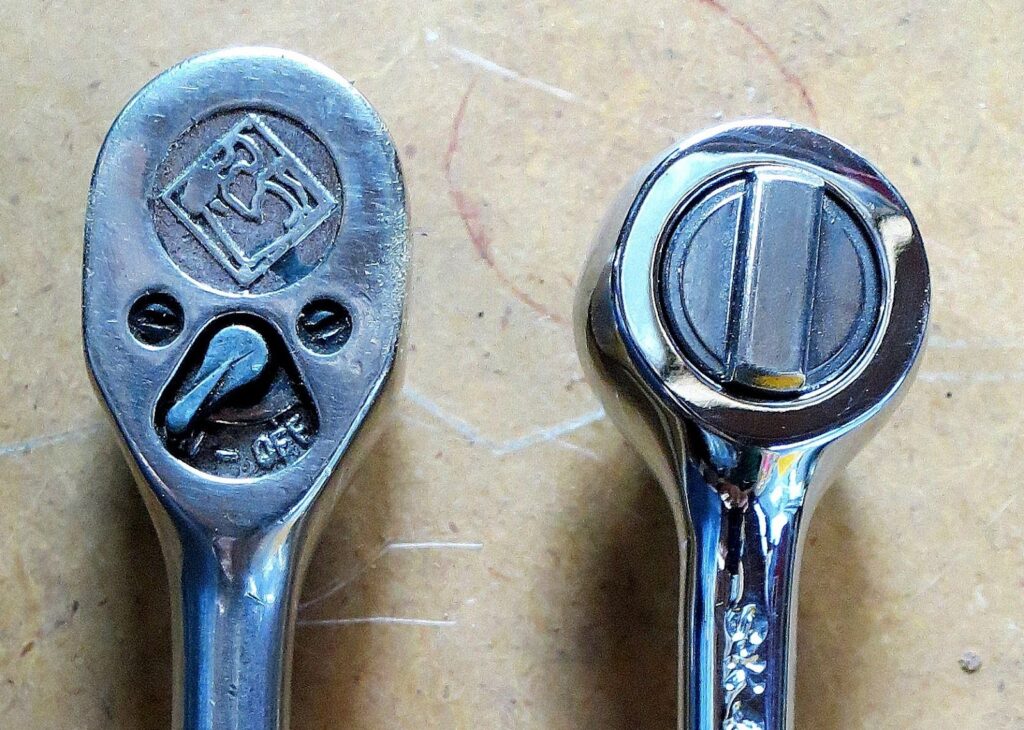You probably have a ton of ratchets in your toolbox. But how can you tell which one is the best for the job? Ratchets come in various designs, sizes, and shapes. Depending on their features, they might excel in some jobs and prove unsuitable for others. Picking the right ratchet for the task is vital to avoid damaging fasteners and make your DIY repair job easier.
What Are the Different Types of Ratchets?
Here’s a quick guide to the different types of ratchets available:
Drive Square Size
When people discuss ratchets, they usually call them by their drive size. The drive size is the diameter of the ratchet’s drive square. Also called the anvil, the drive square is where the socket attaches to the ratchet.

The ¼-inch, ⅜-inch, and ½-inch drive squares are the most prevalent sizes for automotive ratchets. There’s also the ¾-inch drive square ratchet for very heavy work. Usually only heavy equipment and truck mechanics use ¾ drive ratchets.
The ratchet’s drive size restricts it to specific jobs. A small ratchet can’t apply enough force to remove stuck lug nuts, while a bigger tool can’t enter the many tight spots in modern cars and trucks.
Most automotive repair and maintenance jobs require the ⅜-inch ratchet. It’s sufficiently strong for typical fasteners and big enough to apply the appropriate force for everyday tasks while avoiding being too large to fit in many spaces. It’s also easier to tell when you’ve applied sufficient torque so that you don’t break fasteners like you might with a ½ or ¾ square drive ratchet.
Head Shape

Based on shape, the primary types of ratchet heads are the round head and the pear head.
Round-head ratchets have a selector switch built into the back. The switch is usually a knob, and it controls the direction that the ratchet turns.
Pear-head ratchets put their selector switch near their head’s base. They’re less bulky than their round-head counterparts.
Fixed, Flex, and Swivel-Heads
Another way of categorizing ratchets by their head design is by determining if the head can move and how it moves. There are three types: Fixed, flex, and swivel heads.
The flex-head ratchet has a pivot beneath its head. The pivot enables the ratchet’s head to move at a different angle than the handle, allowing the tool to reach fasteners in remote areas.
In comparison, fixed-head ratchets lack the pivot. Their heads stay still and don’t move. Their simple design and less complex manufacturing process makes them less expensive.
Finally, you have swivel-head ratchets. Also called roto-head ratchets, they have round heads with drive squares that rotate 270 degrees. Not only do they work as a ratchet that applies torque, they also operate as a nut driver for immediate extraction of the fastener.
Tooth Count
Tooth count offers another way to classify ratchets. The ratchet’s drive gear features multiple teeth for gripping the fastener’s head. As the tooth count goes up, it reduces the distance you need to move the handle to disengage one tooth and engage the next.
A low-tooth ratchet is also called a coarse ratchet. Its tooth count ranges between 20 and 40 teeth, giving it a swing arc between 18 and 9 degrees. Most coarse ratchets have 36 teeth and a 10-degree swing arc. The coarse tooth ratchet can handle more torque than a fine tooth ratchet but doesn’t work well on fasteners where you don’t have a lot of room to move the handle back and forth.
In contrast, there’s also a high-tooth ratchet. Alternatively called a fine ratchet, it can have between 72 and 160 teeth. Some high-tooth ratchets have additional teeth machined on the drive gear. Other fine ratchets have extra pawls that add bulk and complexity during manufacturing.
Head Release Feature
The anvil (the square part where the socket fits) has a spring-loaded ball that retains the socket while the ratchet is being used. Some ratchets are built so you just pull the socket off, but some others have a button on the back of the ratchet head that releases the socket so it will just fall off instead of you having to pull it off the anvil.
While convenient, the quick release feature can backfire if you accidentally trigger it, ejecting the socket and extension.
Handle Length
You can divide ratchets according to the length of their handles. Ratchet handles come in stubby, standard, long, and extra-long lengths, and you choose based on tight spaces or needed torque.
The length of the handle affects the maximum torque that the ratchet can apply to a fastener. Longer handles deliver more torque. A ratchet with an extra-long handle can let you remove a stubborn fastener without using a larger drive head or a power tool.
However, longer handles don’t work well in tight locations. Most fasteners in those areas aren’t highly torqued, either. Use a stubby ratchet to access those hard-to-reach, relatively lightly torqued fasteners.
Grip Styles
Last but not least is the choice of ratchet grip style. Some ratchets have chrome grips on their handles. They’re uncomfortable, but they require less cleaning and last longer before they need replacement. Knurled grips are fairly common but some ratchets just have a smooth grip and others may have a grip that looks like a screwdriver handle.
Other ratchets feature grips that prioritize comfort. These comfort grips include acetate, plastic, and rubber grips. No matter their material, comfort grips protect your hand from direct contact with the metal handle and improve the ratchet’s ergonomics. However, they degrade faster than chrome grips.
Individual ratchets are usually affordable. However, as they incorporate more features, their price tags increase. You can save money while getting the ratchets that suit your requirements by learning about the different types of ratchets and what they have to offer.
Where to Get the Best Ratchets for Your Repair and Maintenance Needs
Tightening and loosening those pesky nuts and bolts can be frustrating when you don’t have a good ratchet in your toolbox.
So when it’s time to shop for a high-quality ratchet, check out JC Whitney tools. From socket sets to specialty tools, you can trust JC Whitney to have everything you need to get the job done.
While you’re at it, visit the JC Whitney Performance Hub to get the best deals on your favorite performance, off-roading, and restoration brands. Shop for quality off-road, Jeep, truck, classic VW, and restoration parts all in one place.
Any information provided on this Website is for informational purposes only and is not intended to replace consultation with a professional mechanic. The accuracy and timeliness of the information may change from the time of publication.

































